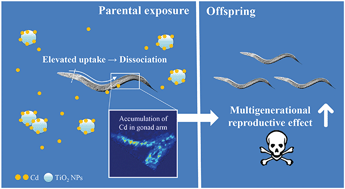Parental exposure to TiO2 NPs promotes the multigenerational reproductive toxicity of Cd in Caenorhabditis elegans via bioaccumulation of Cd in germ cells†
Abstract
Titanium dioxide nanoparticles (TiO2 NPs) can modify the behavior and bioavailability of heavy metals in aquatic environments. However, the influence of TiO2 NPs on the multigenerational impairments caused by heavy metals is largely unknown. This study revealed that parental exposure to TiO2 NPs at a non-toxic concentration could increase the reproductive toxicity of Cd in both the Caenorhabditis elegans (C. elegans) parental generation and subsequent generations (F1, F2) cultured under pollutant-free conditions. TiO2 NPs promoted the ingestion of Cd, and the lower pH environment in the gut accelerated the desorption of Cd from TiO2 NPs, leading to enhanced Cd bioaccumulation, which was confirmed by the expression of metal responsive genes mtl-2, encoding metallothionein. Using laser ablation inductively coupled plasma mass spectrometry (LA-ICP-MS), an in situ imaging technology, we further found that Cd burden in the gonads and embryos was increased by concurrent exposure to TiO2 NPs, indicating the potential transfer of Cd to the next generation through the germline. Our data provided new evidence that maternal exposure to TiO2 NPs amplifies the multigenerational reproductive toxicity of Cd in C. elegans by promoting the accumulation of Cd in germ cells.



 Please wait while we load your content...
Please wait while we load your content...